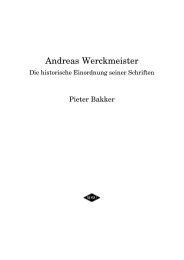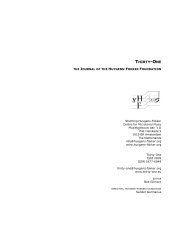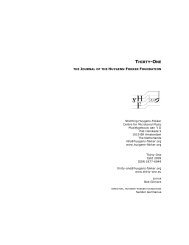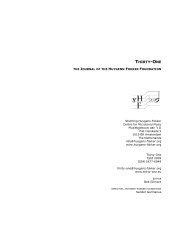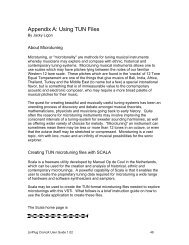Recent Organ Design Innovations and the 21st-century - Stichting ...
Recent Organ Design Innovations and the 21st-century - Stichting ...
Recent Organ Design Innovations and the 21st-century - Stichting ...
Create successful ePaper yourself
Turn your PDF publications into a flip-book with our unique Google optimized e-Paper software.
have continued <strong>the</strong> tradition of <strong>the</strong> Teyler’s Museum performances but have also incorporated parts of<br />
Fokker’s multicultural vision <strong>and</strong> pursued avenues of performance unimagined by Fokker at <strong>the</strong> time of<br />
<strong>the</strong> organ’s invention. For example, one concert in March, 2011, featured <strong>the</strong> organ alongside a<br />
Balinese Gamelan. According to Germanus, <strong>the</strong> thirty-one-tone equal temperament allows <strong>the</strong> division<br />
of <strong>the</strong> fifth into three in a manner similar to both <strong>the</strong> pelog <strong>and</strong> slendro scales of <strong>the</strong> Gamelan. 11 Thus,<br />
in contrast to <strong>the</strong> collision of cultures <strong>and</strong> temperaments evident in Richard Felciano’s seminal 1977<br />
organ-gamelan composition, In Celebration of Golden Rain, <strong>the</strong> organ is featured more at home among<br />
an ensemble foreign to conventional Western tuning systems. In 2010 jazz pianist Guus Janssen<br />
improvised on <strong>the</strong> organ, experimenting with microtonality in <strong>the</strong> jazz idiom, whereas in 2009 a program<br />
titled “Pimp My <strong>Organ</strong>” started an annual tradition of inviting composers to play <strong>the</strong> instrument directly<br />
from a computer, achieving sounds from <strong>the</strong> organ scarcely dreamed of before, such as ultra-fast<br />
gliss<strong>and</strong>i <strong>and</strong> walls of sound similar to <strong>the</strong> filtering techniques of electronic syn<strong>the</strong>sized composition. 12<br />
The Fokker organ, particularly in its new home in Amsterdam, has fulfilled a niche left wanting in<br />
<strong>the</strong> rest of <strong>the</strong> organ world. The fixed twelve-note tuning of traditional pipe organs has precluded <strong>the</strong>ir<br />
use in <strong>the</strong> microtonal music of mid-20th <strong>century</strong> composers. However, while <strong>the</strong> Fokker organ creates a<br />
role for <strong>the</strong> instrument in this body of repertoire, <strong>the</strong> concept has never caught on for a variety of<br />
reasons. Innovative as it is, <strong>and</strong> successful as it may be among <strong>the</strong> Amsterdam arts community, it is hard<br />
to predict what <strong>the</strong> instrument’s future will be among <strong>the</strong> wider organ community. Since its creation<br />
sixty years ago, no o<strong>the</strong>r thirty-one-tone organs have been built. As a consequence, <strong>the</strong> impressive<br />
body of repertoire written for <strong>the</strong> Fokker organ remains relatively unknown <strong>and</strong> may forever be<br />
regarded as novelties of history unless o<strong>the</strong>r thirty-one-tone organs are built. Due to extreme tuning<br />
difficulties <strong>and</strong> unsuitability for <strong>the</strong> vast majority of organ repertoire, I do not see much promise for <strong>the</strong><br />
11 “Concerts,” Huygens-Fokker Foundation Centre for Microtonal Research, accessed March 26, 2011,<br />
http://www.huygens-fokker.org/activities/concerts/fokkerorganconcerts.html.<br />
12 Ibid.<br />
10



